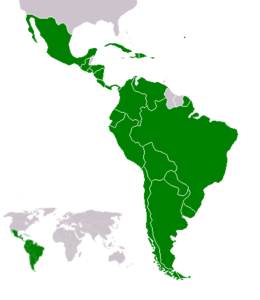With mining, energy, agriculture, and more target verticals represented, Latin America offers a wealth of opportunity for the commercial drone industry. Drone regulations in Latin America are developing rapidly – but a lot of work remains, says ADP Co-Founder Daniel Conde.
Taking Latin American Drones Higher!
By: Dawn M.K. Zoldi
Daniel Conde, Co-Founder de la Asociación de Profesionales de Drones (APD – Drones) and la Asociación de Profesionales de Pilotos (APD – Pilots) has been busy. An entrepreneur and Business Administrator with a Master’s Degree in Entrepreneurship from the Toulouse Business School in France, he’s been passionate about drones since 2014 when he saw one for the very first time. Lately he has been working hard to bring drone technology where it is most needed in Latin America, developing programs such as the Humanitarian Drone network and the Iberoamerican Drone Conference (IDC). Here he provides an explanation of the Latin American regulatory system, predictions for the future, and where to find the best information to operate there.
Latin America consists of Mexico, Guatemala, Honduras, El Salvador, Nicaragua, Costa Rica and Panama, Colombia, Venezuela, Ecuador, Peru, Bolivia, Brazil, French Guiana, Paraguay, Chile, Argentina, Uruguay, Cuba, Haiti, the Dominican Republic and Puerto Rico. Unlike the United States, Europe and Canada, Latin American countries do not yet have an overarching regulatory body to create high level policy guidance. Instead, similar to Africa, each country has its own regulations. Conde states, “In Latin America perhaps we complicate our lives too much. We consist of many medium and small countries and have only a couple of large countries like Brazil and Mexico. Each has its own idiosyncratic way of thinking, of seeing life, and therefore its own drone rules. Having at least one set of common rules, where each country is still able to add their own fingerprint on them, would be ideal. This is what I hope to see in the future.”
According to Conde, although diverse, the regulations have common threads such as flight categories according to the characteristics of the equipment, the weight, the type of operation, certification requirements, remote pilot exams, and registration. The majority of countries also have maximum height rules such as 120 meters above ground level (400 feet) above ground level. In general, countries have framed their rules in internationally familiar terms, with the goal of maintaining safety and security. “Implementation is perhaps what makes Latin America an interesting group of countries,” he says.
Dani is closest to Colombian drone regulations, as he originally hails from there. The country issued its first regulation in September 2015 and updated it in 2018. Similar to the JARUS SORA categories used by many countries (open, specific, certified), Colombia also has three categories:
- Open – More akin to recreational use in the U.S., pilots can only fly drones in the countryside, away from people. Such flights do not require drone registration or pilot certification
- Regulated- Similar to Part 107 in the U.S. and the specific category elsewhere, most commercial drones that weigh up to 25 kg (55 lbs) fall into this group. This category requires drone registration, pilot certification which requires a rigorous 80-100 course with a test and insurance. Under this category, pilots can fly in cities, but not over large crowds of people or carry packages for delivery. Night operations require additional approvals. Beyond visual line of sight (BVLOS) operations require a risk assessment.
- Certified – This category remains a work in progress. It will include larger drones and package deliveries.
The current Colombian drone regulations support several common use cases including photogrammetry for architecture, archaeology and civil engineering; filming and photography and agriculture.
Yet much work remains to be done. Colombia has not tackled the complex issues of remote identification (RID) or unmanned traffic management (UTM). Conde informs that most Latin American countries are thinking about these tough issues. But the pandemic has hit Latin America hard and set back forward progress. “Money that was supposed to be used for research and development programs is now being used for COVID relief and related crisis management, 100% understandable. I just don’t know when UTM/RID will come on board,” he says.
On the other hand, private investment in research is rolling into some key sectors for the drone industry. Conde expects that transportation (think: advanced air mobility) and deliveries focused on the medical and other industries, will soon start taking off.
To help navigate this complex landscape and support the drone industry, the APD provides drone training courses, advice and consultancy. Conde’s team has also negotiated reciprocity agreements between several countries and can help interested businesses and individuals who want to pursue commercial drone activities in multiple Latin American countries. APD specifically has such agreements with Mexico, Argentina, Chile, Colombia and the Dominican Republic. Conde advises, “Having a local contact on the ground can be one of the best ways to operate in compliance with regulations in a foreign country. APD can also assist with those connections.”
The APD also created The IDC-Iberoamerican Drone Conference as a knowledge platform and a meeting point for professionals in the drone industry at the Ibero-American level. “IDC is 100% Spanish and Portuguese-oriented, but it is global. We have translators and include international experts so we can bring the latest developments in the drone world to Iberoamerica,” Conde explains.
Last year, the IDC’s first event, which included 70 speakers from 15 countries, offered 6 master lectures, academic activities, research project presentations, simultaneous and collaborative events, hosted over 1000 participants. This year’s event, IDC 2021, will be the second version of the conference and will occur November 11-13 online. Conde suggests, “Anyone who wants to learn more about drones in Latin America or wants to operate there should join us.”
Besides tapping into this year’s IDC, to learn more about Latin American drone regulations, Conde also recommends:
- Follow @apdpilotos and @idc.community on social media
- Check the civil aviation authority websites for each country in which you plan to fly
- Review apd.ong for additional regulation information
 Dawn M.K. Zoldi (Colonel, USAF, Retired) is a licensed attorney with 28 years of combined active duty military and federal civil service to the Department of the Air Force. She is an internationally recognized expert on unmanned aircraft system law and policy, the Law-Tech Connect™ columnist for Inside Unmanned Systems magazine, a recipient of the Woman to Watch in U.A.S. (Leadership) Award 2019, and the C.E.O. of P3 Tech Consulting L.L.C. For more information, visit her website at: https://www.p3techconsulting.com.
Dawn M.K. Zoldi (Colonel, USAF, Retired) is a licensed attorney with 28 years of combined active duty military and federal civil service to the Department of the Air Force. She is an internationally recognized expert on unmanned aircraft system law and policy, the Law-Tech Connect™ columnist for Inside Unmanned Systems magazine, a recipient of the Woman to Watch in U.A.S. (Leadership) Award 2019, and the C.E.O. of P3 Tech Consulting L.L.C. For more information, visit her website at: https://www.p3techconsulting.com.








[…] Source link […]